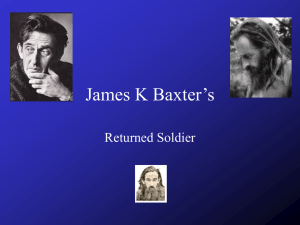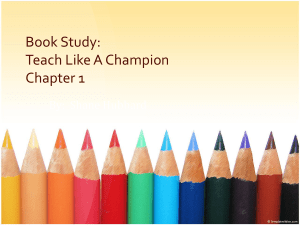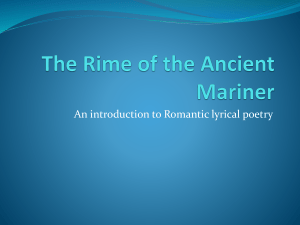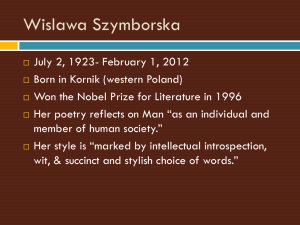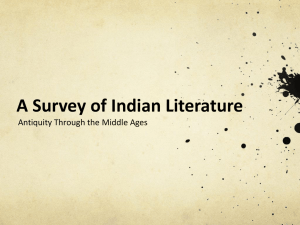Metaphors are Bridges
advertisement
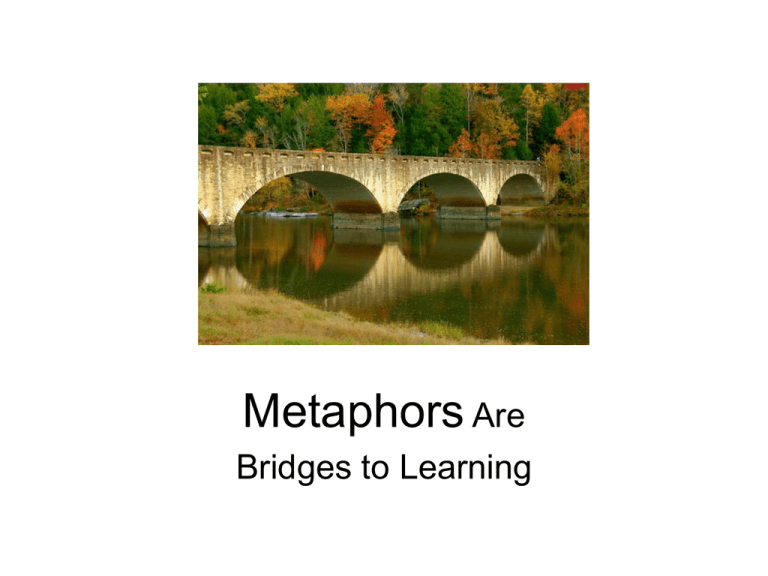
Metaphors Are Bridges to Learning Janis Hill • • • • • ESOL teacher for 4th and 5th graders Brumby Elementary Title I school in CCSD Population 845 students Approximately 20% are ELLs who qualify through the WIDA consortium • Inclusion service model provided in within various content areas • Work with four classroom teachers Inquiry • How can reading and writing poetry engage ELLs in metaphorical thinking? Food for thought: “Shackles off, metaphors are ready to serve any teacher of any subject in any grade level.” Rick Wormeli Raw Facts • Identifying similarities and differences have been positively correlated with student achievement (effect size of 1.61or 45%ile gain), the greatest of any one instructional strategy. It is a basic cognitive activity which deepens understanding. • Four types of instructional activities require students to identify similarities and differences: classifying, comparing, creating metaphors and creating analogies. • Metaphor activities help students understand the abstract features of information. The complex becomes simple. Grist for the mill: • “The key to constructing metaphors is to realize the two ideas, things, or people are connected by an abstract non-literal relationship.” Marzano • Unlike similes, metaphors compare without the use of “like” or “as.” • Metaphor means to transfer or carry over. • Metaphors are more than figurative language, they are conduits for understanding. More to digest: Certain conceptual metaphors such as affection is warmth, importance is big, happy is up, help is support, etc. are universally understood. (paraphrase) Jerome Feldman This tendency can be used to translate common experiences into metaphors. Chew on this: • ELLs remember what they truly understand. • Explicitly teach language clues that indicate comparison: like, similar to, yet, greater than, however, instead of, not only, which, • Teach classification language: feature, trait, common, type, characteristic • Teach persuasive language: evidence, equal, as a result, in order to, argue, weak, due to, because, in my opinion, benefit This vocabulary will become the building blocks of academic language and written expression. Poetry Connection • • • • • • • Poetry is short text. Poetry is fun. Poetry is creative and can be dramatic. Poetry develops oral language. Poetry introduces precise vocabulary. Poetry develops greater fluency. Poetry makes great use of figurative language to create images, including metaphor. Poetry • Poetry has questions. Questions are at the heart of learning. Harvey and Goudvis • Poetry is when emotion has found its thought and the thought has found its words. Robert Frost • Time by Valerie Bloom Half-baked for you …. • Emotions and ideas are good topics for exploring metaphors or comparisons. • They are intangibles which you will probably want to compare to a tangible • How would you describe ___? • How does it make you feel? • What does it remind you of? • What object, emotion, or experience could you compare it to? Why? Let these words simmer awhile on your back burner-- Let’s... Spring is: Adj. Noun PrepPh noisy flowers In a pond Choose the best of each to create a 3 line poem. Spring is___Spring is____ Prepositional Phrase The River by Valerie Bloom Hold Fast to Dreams Hold fast to dreams For if dreams die Life is a broken-winged bird That cannot fly. Hold fast to dreams For when dreams go Life is a barren field Frozen with snow. Langston Hughes Think Aloud Read and listen Ask lots of questions THINK ALOUD Not an easy process for native speakers Notice the imagery and sensory details Hold fast? What kind of dreams? No dreams are like ___ or ____ ? Could it mean? Granny Is by Valerie Bloom Graphic Organizer • Choose a person you know well. Write whatever name s/he goes by in the middle. • Around the web in ray fashion list what he looks like, feels, does, says, wishes, fears • For now ignore spelling, grammar, complete sentences. • Don’t worry about rhyme. • Choose the 3 or 4 best verbs for each verse. • Begin with _______is for each verse. • Add at least three lines to each verse. • Check to see if you have strong verbs and good imagery. • Look at rhyme and meter if you have time. For Voracious Readers (Works Cited) Bloom, Valerie. Valerie Bloom Reading From Her Poems. The Poetry Archive, 2005. CD. Web. Feldman, Jerome. From Molecule to Metaphor: Neural Theory of Language. Cambridge, MA: MIT P. 2008. Print. Gallagher, Kelly. Deeper Reading: Comprehending Challenging Texts. Portland, ME: Stenhouse. 2001. Print. Harvey, Stephanie, and Anne Goudvis. Strategies That Work: Teaching Comprehension to Enhance Understanding. York, ME: Stenhouse. 2000. Print. Hughes, Langston. “All Poems of Langston Hughes”. PoetryHunter.com. N.p. n.d. Marzano, Robert, Debra J. Pickering, and, Jane E. Pollock. Classroom Instruction That Works: Research-Based Strategies for Increasing Student Achievement. Alexandria, VA: Association for Supervision and Curriculum Development. 2001. Print. Marzano, Robert. Building Background Knowledge for Academic Achievement. Alexandria, VA:Association for Supervision and Curriculum Development. 2004. Print. Wormeli, Rick. Metaphors and Analogies: Power Tools for Teaching Any Subject. Portland, ME: Stenhouse, 2009. Print.
